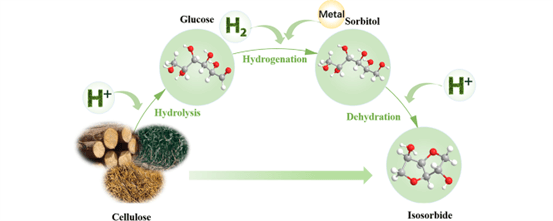 Open Access
Open Access
REVIEW
Key Steps and Catalyst Performance for Conversion of Cellulose to Isosorbide: A Review
State Key Laboratory of Heavy Oil Processing, China University of Petroleum-Beijing, Beijing, 102249, China
* Corresponding Author: Ying Yang. Email:
(This article belongs to the Special Issue: Recent Advances on Renewable Materials)
Journal of Renewable Materials 2025, 13(1), 49-78. https://doi.org/10.32604/jrm.2024.056644
Received 27 July 2024; Accepted 20 September 2024; Issue published 20 January 2025
Abstract
Upgrading of abundant cellulosic biomass to isosorbide can reduce the dependence on limited fossil resources and provide a sustainable way to produce isosorbide, utilized for polymers, medicine and health care product synthesis. This review comprehensively examines the key steps and catalytic systems involved in the conversion of cellulose to isosorbide. Initially, the reaction pathway from cellulose to isosorbide is elucidated, emphasizing three critical steps: cellulose hydrolysis, glucose hydrogenation, and the two-step dehydration of sorbitol to produce isosorbide. Additionally, the activation energy and acidic sites during cellulose hydrolysis, the impact of metal particle size and catalyst support on hydrogenation, and the effects of catalyst acidity, pore structure, and reaction conditions on sorbitol dehydration have been thoroughly examined. Finally, the progress made in cellulose conversion to isosorbide is summarized, current challenges are highlighted, and future development trends are projected in this review.Graphic Abstract

Keywords
Cite This Article
 Copyright © 2025 The Author(s). Published by Tech Science Press.
Copyright © 2025 The Author(s). Published by Tech Science Press.This work is licensed under a Creative Commons Attribution 4.0 International License , which permits unrestricted use, distribution, and reproduction in any medium, provided the original work is properly cited.


 Submit a Paper
Submit a Paper Propose a Special lssue
Propose a Special lssue View Full Text
View Full Text Download PDF
Download PDF Downloads
Downloads
 Citation Tools
Citation Tools